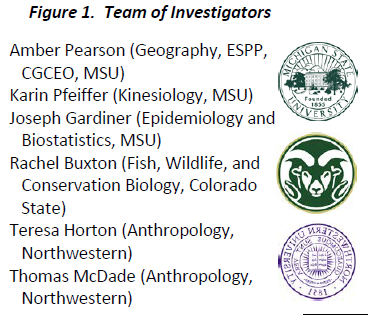The health benefits of neighborhood greenspaces – NIH funds research on causal connections
August 6, 2019
A walk in the park, a field of wildflowers, a robin serenade. Intuitively we know that communing with the natural world can stimulate a sense of wellbeing. Some may even have heard of the Japanese concept of “forest bathing”. Yet science has some distance to go to uncover the causal pathways that connect ecological stimuli – both visual and auditory – with specific health outcomes. MSU’s own Dr. Amber L. Pearson and her colleagues have a plan to do just that.
Recently awarded $3.3 million by the National Institutes of Health, Dr. Pearson leads a highly interdisciplinary, multi-university team (Figure 1) who will investigate whether over time, exposure to green space will lead to improved physical activity and downstream cardio-metabolic health for residents of several low-income neighborhoods in the City of Detroit. 
Working collaboratively with Audubon, Detroit Parks, and an Advisory Group of neighborhood residents, the team will bring together data from geospatial technologies, kinesiology, biostatistics, ecological acoustics, environmental physiology, and biological anthropology.
This project is the first natural experiment to examine the impact of ecological restoration with individual-level measurement of exposure to greenspace on health. The study’s focus on an understudied population, employment of novel geospatial science, measurement of biomarkers, and a rich, synergistic partnership also set this research apart.
Here scientific merit connects with engaged scholarship and the ethic of “giving back” to the community. Some years ago, Pearson observed that there were not many high quality, public spaces in many cities – particularly in low income, minority neighborhoods -- with free, inclusive, easy access for residents to engage in social activity, relaxation, exercise, play, read a book, or simply enjoy nature. At the same time, in Detroit, the city is struggling to maintain city services and repurpose vacant properties. Findings from this research initiative could help change that scenario.
According Pearson et al., “If our hypotheses prove correct, our findings will highlight an unusually low-cost avenue for lowering stress and improving weight management to reduce persistent health inequalities”, not only for the City of Detroit, but for other cities managing parks and other greenspaces as well.
To learn more about this important work, you can check out the following resources:
Beyer, K., et al. (2014). "Exposure to Neighbourhood Green Space and Mental Health: Evidence from a survey of the health of Wisconsin." Int J Environ Res Public Health 11(3): 3453–3472.
Hunter, R. F., et al. (2019). "Environmental, health, wellbeing, social and equity effects of urban green space interventions: A meta-narrative evidence synthesis." Environ Int 130: 104923.
Nutsford, D., et al. (2013). "An ecological study investigating the association between access to urban green space and mental health." Public Health 127(11): 1005-1011.
Pearson, A. L., et al. (2019). "Initial Evidence of the Relationships between the Human Postmortem Microbiome and Neighborhood Blight and Greening Efforts." Annals of the American Association of Geographers 109(3): 958-978.

